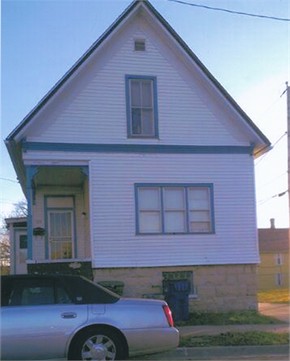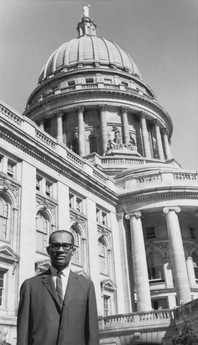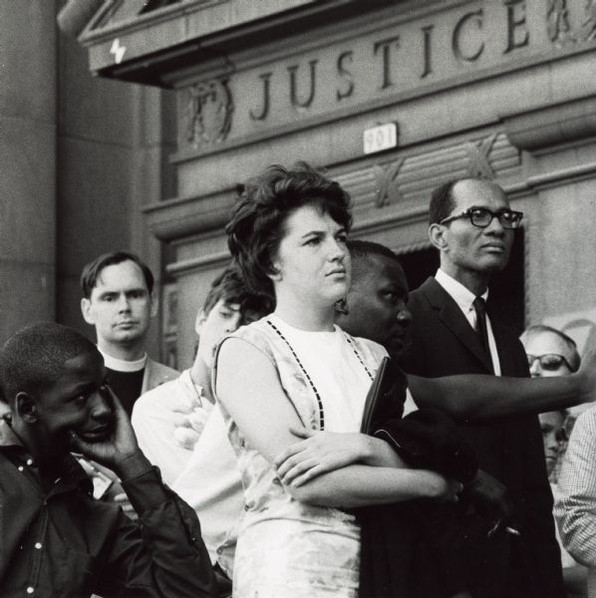Lloyd A. Barbee House
Introduction
Text-to-speech Audio
This house, built in 1890, was once the home to important Civil Rights Lawyer Lloyd A. Barbee. Barbee, considered "Wisconsin’s most prominent twentieth-century civil rights activist" (Wisconsin Historical Society), is best known for his work to integrate Milwaukee Public Schools in the 1960s. The house was added to the National Register of Historic Places and made an official landmark of the city and state in 2019 to honor his service to the city of Milwaukee.
Images
Barbee House, 2019. Photo credit: Wisconsin Historical Society

Lloyd Barbee at the Wisconsin Capitol Building, 1964. Photo Credit: Wisconsin Historical Society

Lloyd Barbee at the Wisconsin Capitol Building, 1964. Photo Credit: Wisconsin Historical Society

Barbee and others at a Civil Rights rally, 1966. Photo credit: Wisconsin Historical Society

Barbee re-election campaign sign, 1968. Photo credit: UWM archives

Backstory and Context
Text-to-speech Audio
This modest Near North Side house was built in 1890 during the neighborhood's development between 1870-1910. By the 1960s the neighborhood was predominantly African American. Lloyd Barbee bought his house in 1966 and lived there until 1980. The house is a single-family small home built in the Victorian style.
Lloyd A. Barbee (1925-2002) was an attorney, Wisconsin State Assemblymember for twelve years, and civil rights leader. He was President of the Madison branch of the NAACP in 1955, a year before he received his law degree from the University of Wisconsin Law School. In 1961 Barbee conducted his first Civil Rights hearing at the Wisconsin State Capitol in support of open housing and earned the election of President to the state's NAACP. The following year he moved to Milwaukee and formed the Milwaukee United School Integration Committee (MUSIC) to confront the harsh segregation of the city's public schools. Barber was elected to the Wisconsin State Assembly in 1964.
In 1965, Barbee and his team decided that the most effective way to support integration was to make a public legal stand with a federal lawsuit. That suit became Amos et al. v. Board of School Directors of the City of Milwaukee, 408 F. Supp. 765 and suit represented 41 Black and white students and claimed that the school board intentionally upheld segregation, strengthening it in the face of overcrowding instead of weakening it. The lawsuit was in court until 1976, when Federal Judge John Reynolds ruled, “I have concluded that segregation
exists in the Milwaukee public schools and that this segregation was
intentionally created and maintained by the defendants.”1
From 1966-1980, his Near North Side home doubled as his office, serving as a hub of Civil Rights activity. Fellow activists such as comedian Dick Gregory often stayed with Barbee in his guest bedroom. It was here also that Barbee fought appeals to the landmark ruling and devised practical solutions for desegregation in Milwaukee.
Barbee's activism and progressive work extended beyond integration. He worked for fair employment, prison reform, LGBTQ rights, and equal rights for women and minorities. Barbee's legacy of fighting for equal rights in Wisconsin was recognized by the city in 2019 and his home of fourteen years was added to the National Register of Historic Places.
Sources
1Amos et al. v. Board of School Directors of the City of Milwaukee, 408 F. Supp. 765 (1976). March on Milwaukee. . Accessed July 21, 2019. https://uwm.edu/marchonmilwaukee/keyterms/amos-et-al-v-board-of-school-dir/.
Lloyd Barbee. March on Milwaukee. . Accessed July 21, 2019. https://uwm.edu/marchonmilwaukee/keyterms/barbee-lloyd-a/.
321 E Meinecke Ave Property Record. Wisconsin Historical Society. . Accessed July 21, 2019. https://www.wisconsinhistory.org/Records/NationalRegister/NR2601.
Lloyd Barbee. March on Milwaukee. . Accessed July 21, 2019. https://uwm.edu/marchonmilwaukee/keyterms/barbee-lloyd-a/.
321 E Meinecke Ave Property Record. Wisconsin Historical Society. . Accessed July 21, 2019. https://www.wisconsinhistory.org/Records/NationalRegister/NR2601.
